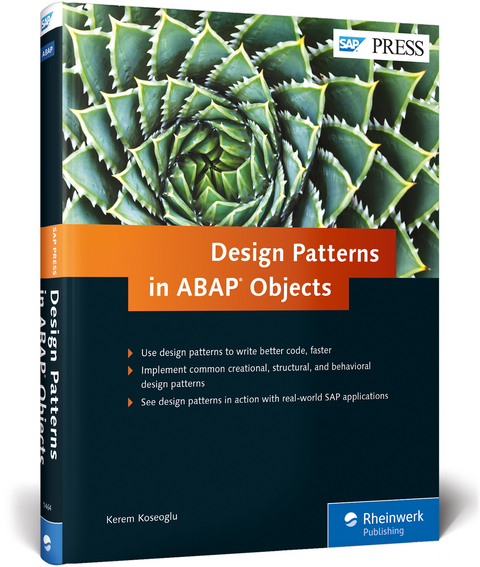
Design Patterns in ABAP Objects
SAP Press (Verlag)
978-1-4932-1464-8 (ISBN)
Use design patterns to step up your object-oriented ABAP game, starting with MVC! Want to create objects only when needed? Call objects only when required, minimizing runtime and memory costs? Reduce errors and effort by only coding an object once? Future-proof your code with a flexible design? Design patterns are the answer! With this guide, you'll get practical examples for every design pattern that will have you writing readable, flexible, and reusable code in no time! Creational Design Patterns: Create objects with the abstract factor, builder, factory, lazy initialization, multiton, prototype, and singleton design patterns. Structural Design Patterns: Allow objects to interact and work together without interdependency with the adapter, bridge, composite, data access object, decorator, facade, flyweight, property container, and proxy design patterns. Behavioral Design Patterns: Increase the flexibility of your object communication with the chain of responsibility, command, mediator, memento, observer, servant, state, strategy, template method, and visitor design patterns. Highlights:
MVC (model, view, controller) pattern
Singleton pattern
Factory pattern
Builder pattern
Observer pattern
Visitor pattern
Lazy initialization pattern
Template method
Strategy pattern
Decorator pattern
ABAP-specific examples
Anti-patterns
Dr. Kerem Koseoglu is a freelance SAP software architect, working professionally since 2000. He specializes in the development of comprehensive applications using design patterns and also conducts technical training related to design patterns. He has participated in global software development projects, taking diverse roles including lead architect, team lead, developer, technical advisor, instructor, and project manager. His former publications include four books and countless articles for technical magazines in Turkey. He has a Ph.D. in organizational behavior.
Preface
Design Pattern Categories
How to Learn
PART I Architectural Design Patterns
MVC
Case Study: Read, Process, Display, and Post
Passing Select Options
Distributing Application Logic
Related Patterns
Summary
Creational Design Patterns
Abstract Factory
Case Study: Log Analysis
Related Patterns
Summary
Builder
Case Study: Jobs for Text Files
When to Use
Privacy
Summary
Factory
Case Study: FI Documents for Parties
Advantages
Related Patterns
Summary
Lazy Initialization
Case Study: Logging Errors
Advantages
Related Patterns
Summary
Multiton
Case Study: Vendor Balance
When to Use
When to Avoid
State Modification
Summary
Prototype
Case Study: Item Clone
Changing Class Properties
Clone Operations
Related Patterns
Summary
Singleton
Case Study: Subcomponents
Advantages and Disadvantages
Related Patterns
Summary
Structural Design Patterns
Adapter
Case Study: Project Management Tools
Glue Code
Two-Way Adapters
Legacy Classes
Summary
Bridge
Case Study: Messaging Framework
Advantages
Summary
Composite
Recursive Programming: A Refresher
Case Study: HR Positions
Advantages
Disadvantages
When to Use
Related Patterns
Summary
Data Access Object
Case Study: Potential Customers
Redundant Code Prevention
Related Patterns
Summary
Decorator
Case Study: User Exit
Advantages and Challenges
Related Patterns
Summary
Facade
Case Study: Bonus Calculation
When and Where to Use
Related Patterns
Summary
Flyweight
Case Study: Negative Stock Forecast
Disadvantages
When to Use
Related Patterns
Summary
Property Container
Case Study: Enhancing an SAP Program
Static vs. Instance Containers
Sharing Variables
Variable Uniqueness
Related Patterns
Summary
Proxy
Case Study: Sensitive Salary Information
When to Use
Related Patterns
Summary
Chain of Responsibility
Case Study: Purchase Order Approver Determination
Risks
Related Patterns
Summary
Behavioral Design Patterns
Command
Case Study: SD Documents
When to Use or Avoid
Related Patterns
Summary
Mediator
Case Study: Stock Movement Simulation
When to Use
Disadvantages
Summary
Memento
Case Study: Budget Planning
Risks
Redo
Summary
Observer
Case Study: Target Sales Values
Advantages
Disadvantages
Multiple Subjects
Related Patterns
Summary
Servant
Case Study: Address Builder
Extensions
Related Patterns
Summary
State
Case Study: Authorization-Based Class Behavior
Advantages
Related Patterns
Summary
Strategy
Case Study: Sending Material Master Data
Advantages
Passing Data to the Strategy Object
Optional Strategies
Intermediate Abstract Classes
Related Patterns
Summary
Template Method
Case Study: Average Transaction Volume
When to Use
Advantages and Risks
Degree of Abstraction
The “Hollywood Principle”
Summary
Visitor
Case Study: Incoming Invoice Processing
When to Use
Related Patterns
Summary
Appendices
Object-Oriented Programming
Subclass Determination
Principles
The Author
Index
| Erscheinungsdatum | 19.11.2016 |
|---|---|
| Reihe/Serie | SAP PRESS Englisch |
| Verlagsort | Maryland |
| Sprache | englisch |
| Maße | 175 x 229 mm |
| Themenwelt | Mathematik / Informatik ► Informatik ► Netzwerke |
| Informatik ► Office Programme ► Outlook | |
| Mathematik / Informatik ► Informatik ► Programmiersprachen / -werkzeuge | |
| Informatik ► Weitere Themen ► SAP | |
| Wirtschaft ► Betriebswirtschaft / Management | |
| Schlagworte | 1464 • ABAP objects • ABAP OOP • ABAP OOPS • ABAP; Spezielle Anwendungsbereiche • Object oriented programming (OO) • Objektorientierte Programmierung • OO-ABAP |
| ISBN-10 | 1-4932-1464-0 / 1493214640 |
| ISBN-13 | 978-1-4932-1464-8 / 9781493214648 |
| Zustand | Neuware |
| Informationen gemäß Produktsicherheitsverordnung (GPSR) | |
| Haben Sie eine Frage zum Produkt? |
aus dem Bereich


